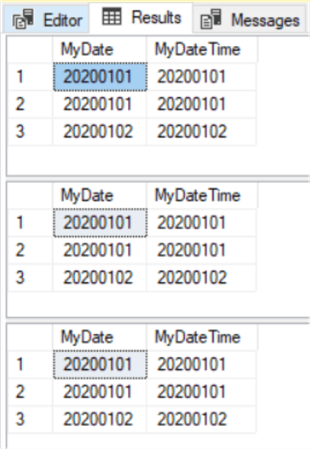Convert(varchar, getdate, 112) I notice that if I use the second one, it will append two spaces after the date. 20130705 - notice the two space after the value 20130705 ). You may need to convert the date to get date in your format using the below query Try with the below query SELECT CONVERT(nvarchar(6), DATEADD(month, 2, GETDATE), 112).
- UPDATE CED WITH (TABLOCKX) SET CED.EndDate = ISNULL (CED.CalculatedEndDate, CONVERT(date, '99991231', 112)) FROM (SELECT E.EndDate, CalculatedEndDate = DATEADD(DAY, -1, LEAD(E.StartDate) OVER (PARTITION BY E.SomeID ORDER BY E.StartDate)) FROM dbo.Example AS E) AS CED OPTION (MAXDOP 1, QUERYTRACEON 7470); The new post-execution plan is.
- I would convert it to a datetime first, then to the format that you want: declare @day varchar(10) set @day = '6/21/2013' select convert(varchar(10), cast(@day as datetime), 112); See SQL Fiddle with Demo.
- CONVERT(NVARCHAR, @Date, 114) AS '114';- HH:mi:ss:mmm ちょっと話はそれますが、現在のところ、SQL Server のカットオフ年のデフォルトは 2049 年です。 ですので、年を 2 桁で扱う時、1/1/49 といえば 2049 年 1 月 1 日、 そして、1/1/50 は 1950 年 1 月 1 日とみなされてしまいます。.

When you have a date or datetime column in an SQL database, it will output a value that looks like 2017-01-01 00:00:00.000
This is the standard format used for datetime columns in SQL Server and saves the details as YYYY-MM-DD HH:MI:SS
But if you need to display the datetime in a human readable format you will need to convert it using the CONVERT function.
For example, to convert the column ‘Date_Of_Birth’ to dd-mm-yyyy format.
What about other date formats?
You can easily use different formats by replacing the 105 value with the value for your format
| Code | Output | Format |
|---|---|---|
| 101 | mm/dd/yyyy | USA |
| 102 | yyyy.mm.dd | ANSI |
| 103 | dd/mm/yyyy | British/French |
| 104 | dd.mm.yyyy | German |
| 105 | dd-mm-yyyy | Italian |
| 106 | dd mon yyyy | – |
| 107 | Mon dd, yyyy | – |
| 108 | hh:mm:ss | – |
| 109 | mon dd yyyy hh:mi:ss:mmmAM (or PM) | Default + millisec |
| 110 | mm-dd-yyyy | USA |
| 111 | yyyy/mm/dd | Japan |
| 112 | yyyymmdd | ISO |
| 113 | dd mon yyyy hh:mi:ss:mmm (24h) | Europe default + millisec |
| 114 | hh:mi:ss:mmm (24h) | – |
| 120 | yyyy-mm-dd hh:mi:ss (24h) | ODBC canonical |
| 121 | yyyy-mm-dd hh:mi:ss.mmm (24h) | ODBC canonical (with milliseconds) default for time, date, datetime2, and datetimeoffset |
| 126 | yyyy-mm-ddThh:mi:ss.mmm (no spaces) | ISO8601 |
| 127 | yyyy-mm-ddThh:mi:ss.mmmZ (no spaces) | ISO8601 with time zone Z |
| 130 | dd mon yyyy hh:mi:ss:mmmAM | Hijiri |
| 131 | dd/mm/yy hh:mi:ss:mmmAM | Hijiri |
Reference: https://www.w3schools.com/sql/func_convert.asp
I often get asked how to convert a datetime into Julian Date format in T-SQL. People have differing opinions about what Julian means, but the one I got asked about most recently meant YYDDD, as often used by mainframe systems (I think this is Julian Date, as opposed to Julian Day which is the number of days since 4713BC). SQL Server doesn’t have a TO_JULIAN function, but we can make one easily enough.
So we’re wanting to express a date as YYDDD, where YY is the two-digit form of the year, and DDD is the number of days since Dec 31st of the previous year (ie, the DDDth day of the year).
Using the DATEPART function can get each part. YY for the year, and DY for the day of the year. I’m going to use @date as a variable here, of type datetime. Using the date type in SQL 2008 would work just the same.
SELECT DATEPART(yy, @date), DATEPART(dy, @date)
However, to make sure that we have the year in two-digits only, we should convert this to a string and get the rightmost two characters.
SELECT RIGHT(CAST(DATEPART(yy, @date) AS char(4)),2)
We also need to pad the DDD with zeroes – which I’ll do by putting three zeroes in front of the number and getting the three rightmost characters.
Ms Sql Convert 112
SELECT RIGHT(‘000’ + CAST(DATEPART(dy, @date) AS varchar(3)),3)
Concatenating the YY and the DDD, we now have a TO_JULIAN function.
SELECT RIGHT(CAST(YEAR(@date) AS CHAR(4)),2) + RIGHT(‘000’ + CAST(DATEPART(dy, @date) AS varchar(3)),3)
Converting back again isn’t too hard – it’s just a matter of pulling the numbers out of the 5-character string. I’m going to assume we have a char(5) called @julian.
We need to split the string up first.
SELECT LEFT(@julian,2), RIGHT(@julian,3)
The first bit becomes the year easily enough
SELECT CONVERT(datetime, LEFT(@julian,2) + ‘0101’, 112)
Sql Convert 112
The second half can be cast to a number, and then added back (subtracting one to get the maths right) using DATEADD.
SELECT DATEADD(day, CAST(RIGHT(@julian,3) AS int) – 1, CONVERT(datetime, LEFT(@julian,2) + ‘0101’, 112))
So now we have a FROM_JULIAN function:
SELECT DATEADD(day, CAST(RIGHT(@julian,3) AS int) – 1, CONVERT(datetime, LEFT(@julian,2) + ‘0101’, 112))
Convert Datetime To Date Sql
Easy stuff really, just a matter of thinking about what we mean by a particular format.
